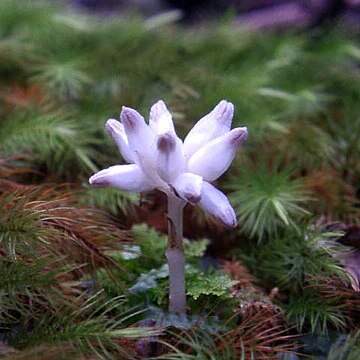Annual or perennial, autotrophic or saprophytic herbs, the saprophytic species often colorless; stem simple or branched, beset with scale-like leaves, in the non-saprophytic species usually with a rosette of linear leaves at the base; flowers solitary or in groups at the top of the stem or in dense terminal cymose or head-like inflorescences; perianth limb usually consisting of 6 lobes, the outer 3 being much larger, inner ones often minute, tube cylindrical-trigonous; anthers 3, sub-sessile in the perianth throat below the inner lobes; style filiform, branching at the top into 3 short branches, each bearing a stigma; ovary trigonous, 3-celled, placentas axile; in most species ovary and perianth tube prominently 3-winged, although not in those of Panama; ovary crowned by the persistent, dried perianth, dehiscing irregularly; seeds many, oblong or ellipsoid.
Herbs, annual or perennial, mycotrophic, semi-mycotrophic, or autotrophic, sometimes rhizomatous. Stems simple, rarely branched. Basal leaves in a distinct rosette; cauline leaves bractlike, small. Flowers solitary or in terminal cymes. Perianth tube actinomorphic, cylindric or trigonous, with 3 lateral wings or sometimes wings absent, without annulus at tube mouth; tepals generally 6, apically distinct; outer tepals larger than inner, unlobed; inner tepals often minute, occasionally lacking. Stamens 3, sessile or subsessile on perianth tube; connective with 0-2 apical and 0 or 1 basal appendages. Ovary trigonous, 3-loculed, with axile placentation; stigmas 2-labiate to funnel-shaped. Fruit capsular, with persistent perianth, dehiscence generally irregular.
Plants annual, autotrophic, at least partly green. Rhizomes absent. Roots filiform. Stems usually unbranched, green. Leaves cauline, sometimes basal, green, purplish, or pale, scalelike to linear. Inflorescences 2–25-flowered cymes or flowers solitary; floral bracts sometimes appearing imbricate if internodes of cyme rachis are very short; pedicels 0–1 mm. Flowers erect, 3-ribbed to 3-winged; perianth persistent in fruit; annulus absent; stamens 3, proximal to inner perianth lobes, sessile; ovary 3-locular; placentation axile. Capsules obovoid to ellipsoid, transversely dehiscent.
Annual or perennial, saprophytic and colourless or chlorophyllose. Flowers often 3-winged. Perianth limb usually consisting of 6 lobes; the outer ones being much larger; inner 3 often minute, sometimes lacking. Perianth tube cylindrical to trigonous. Anthers 3; connective sometimes with 2 apical crests and/or a hanging, median, basal spur. Style filiform, branching into 3 short branches, each bearing a stigma, or 3 sessile stigmas at the apex of the style. Ovary trigonous. Fruit capsular, mostly dehiscing irregularly. Seeds many, oblong or ellipsoid.

